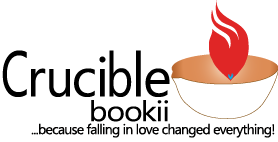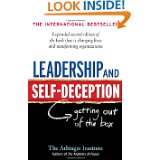A Different Way of Thinking Outside the Box: A Book Review of The Arbinger Institute’s Leadership and Self-Deception
Written by Jen Dawson under Melanie’s direction
This is not a new book. Published in hardcover in 2000, the four pages of glowing reviews found inside the front cover, gathered from corporate heavy-hitters like Fed-Ex and anonymous readers from across North America, give a sense that the book has been around long enough to gain quite a following. The concept of self-deception is also not new. “Know Thyself” was inscribed over the entrance to the Oracle at Delphi. More recently, the psychoanalytic theory of Freud and co. could be described as the study of the many ways humans lie to themselves. In fact, the concepts explored in Leadership and Self-Deception are the Arbinger Institute’s take on the psychoanalytic concept of ‘resistance’ as applied to the world of business.
The book is engagingly written, following the popular business book format of the likeable but imperfect main character who learns a life-altering lesson from a selection of gentle and inspiring gurus. At 168 pages, it’s a quick read. The concepts are clearly presented, the dialogue believable, and the take-away lesson profound.
We journey along with Tom Callum, a fictional new employee at a highly successful company where the secret weapon–being “out of the box” in relations with others–has revolutionized the way business is done. Over the course of two days, Tom learns that all people, including his mentors, have a tendency to see others as objects rather than people.
It all starts when we deny an initial impulse to do something for another person. This act of denial is labelled self-betrayal. In order to continue seeing ourselves as good people, even though we didn’t follow through on our own impulse to help another, we have to rationalize our inaction. The other person’s character and behaviour is vilified, while our own deeds and needs are elevated in our perception. Both are distortions of reality. At the fictional company where the book is set, this place of distorted reality is given the label “being in the box”.
Simple examples of box-behaviour described in the book include cutting off a fellow driver, failing to hold the elevator door for someone, and leaving a crying baby for our partner to tend; in each of these cases there was an impulse to act differently but a choice not to. More complex examples include relations with family members and co-workers, where distortions of reality and objectification of others have become entrenched, self-fulfilling and mutually reinforcing. In all cases, there is a focus on self at the expense of others. The result is destructive conflict, lower productivity and non-constructive competition.
The answer to being “out of the box” is simply to see others as people. When we recognize the humanity of others and see their needs and desires as equal to our own, we see things as they really are rather than as a distorted, self-promoting reality. Since we no longer have to defend our distorted view of reality, we are freed up to engage with others in constructive problem-solving and true celebration of their successes. In the business world, “out of the box” employees, because they aren’t focused on themselves, are able to focus on achieving results for the company.
Reading this book was like having a epiphany for me, an experience that is corroborated by the executives to whom we have recommended it, all of whom assert that it affected their work and personal lives in a profound way. The four pages of testimonials, apparently, don’t lie.
Sage Portfolio Group was so impressed with the concepts that it has developed training and follow-up coaching programs for companies wishing to develop their own “out of the box” culture. We have found that application of these principles has resulted in a fundamental shift in the way executives think about their team and employees, and adoption of a common language to resolve conflict. “I found that the executives use the concept of ‘being out of the box’ in both professional and personal practice,” says Sylvia Goodeve, certified coach with Sage Portfolio Group. “They will use this concept in preparing for a critical meeting, for performance reviews, for a challenging conversation with someone, and have reported positive results in realizing the outcomes they wanted to see.” Ileana Vassiliou, a corporate coach who has delivered training based on the Leadership and Self-Deception principles, agrees. “We have utilized it so people in the organization can get to the facts and problem solve without rehashing the same problems over and over again. As a result, people look for how to improve processes rather than for who to blame. The net result is not only problem solving but a huge gain in productivity.”
What the Arbinger Institute gives us in Leadership and Self-Deception, ultimately, is a nutrient-rich meal packaged as fast food. The book hints at more substantial business applications, but these might not be so tasty and easily digested.




